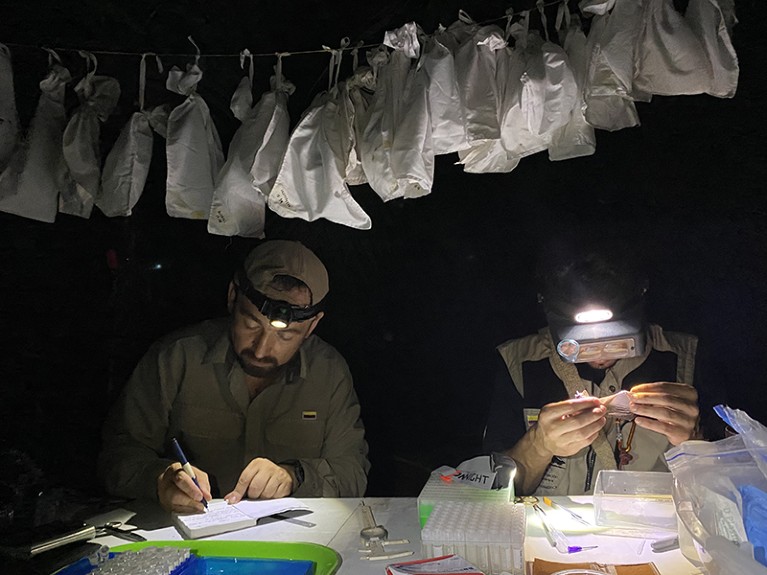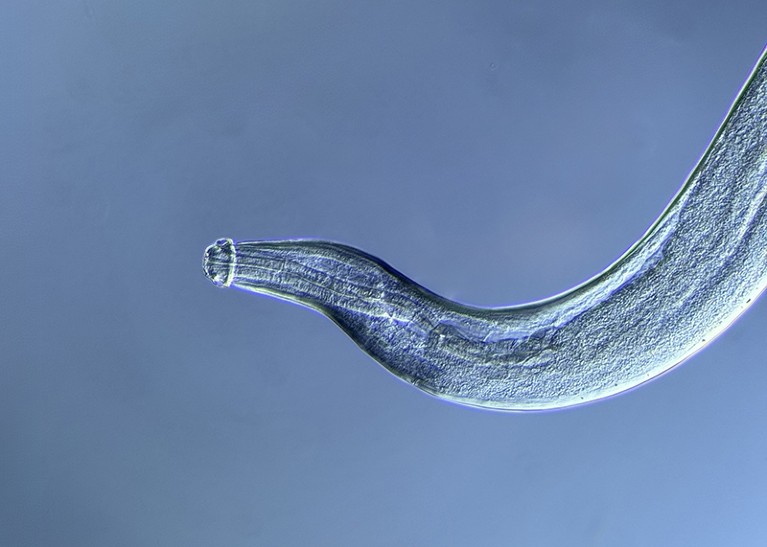Before studying parasites, this PhD researcher was their host
Kevin Liévano-Romero abandoned a veterinary career in Colombia to move to the United States, where he studies feared but fascinating creatures.
Převzato z: Nature.com, 21. květen, www.nature.com
Working scientist profiles
This article is part of an occasional series in which Nature profiles scientists with unusual career histories or outside interests.
The concoction tasted terrible, Liévano-Romero recalls, adding: “I was scared, panicked, but at the same time, fascinated. Those organisms can live in my intestine, and they are so resistant!”
That fascination never left him. Today, Liévano-Romero is a fourth-year parasitology PhD student at the University of Nebraska-Lincoln, studying bat parasites. Colombia boasts around 200 bat species, ranking behind only Indonesia, and all of them are likely to host at least one species of parasite, says Liévano-Romero. His research also focuses on the viruses that infect bat parasites, and on how the viruses affect their hosts’ fitness and susceptibility to infections. Because bats can harbour some of the deadliest parasites that exist in tropical places such as Colombia — including Trypanosoma cruzi, which causes Chagas disease — understanding the complex interplay between their parasites and viruses is crucial for public health.
But, unlike most people, Liévano-Romero doesn’t find the bats, the parasites or even the viruses scary: he says their complexity makes them beautiful.
Drawn to wildlife
Liévano-Romero’s nature-loving parents instilled in him a respect for all creatures during a childhood when infestations of fleas and intestinal worms were common. In 2010, aged 16, he joined the National University of Colombia’s prestigious veterinary-medicine programme in Bogotá, becoming the first person in his family to attend university. During his eight-year education, Liévano-Romero volunteered in wildlife clinics. Colombia has one of the highest rates of illegal wildlife trafficking, he says, and he worked with animal victims of that trade, from pygmy hedgehogs to eagles to anteaters. He also ventured into the field with Miguel Rodríguez-Posada, a mammologist affiliated with the university who was studying bats.

Miguel Rodríguez-Posada (left) identifies bat species during field work in Colombia, and Kevin Liévano-Romero (right) dissects the animals so that he can collect ecto- and endoparasites from them.Credit: Kevin Liévano-Romero
“We went at night to the forest, and when I got the first bat in my hands, I just thought, ‘Wow, this is a fascinating creature … I want to investigate much more.’” A love for his classes in internal medicine and pathology led to a dissertation on bat ectoparasites, such as lice, ticks and bat flies. The research culminated in the first-ever documentation of dozens of bat-parasite species in Colombia1.
After graduating in 2018, Liévano-Romero worked as a vet in Bogotá for three years and helped Rodríguez-Posada with biodiversity field surveys, frequently contracting parasitic infections through contact with animals. He reels off what he was infected with: “all kind of worms … fleas, lice, ticks … blood parasites because of the tick bites or mosquitoes.”
Over-the-counter medications helped him to recover quickly. Infections in big cities such as Bogotá are less common, but they’re ubiquitous in lowland rural areas such as those where his cousins live, and where he does fieldwork. There, traditional medicine is still a more common treatment.
Liévano-Romero has often returned to the concoctions that his family made him as a child when he caught intestinal worms — ‘smoothies’ mixed from the native paico herb (Dysphania ambrosioides), castor oil and garlic. He would also sleep with eucalyptus leaves under the mattress, to ward off parasites in the field. Later, he learnt from Indigenous field guides to spray himself with a liquid mixture of alcohol and tobacco, to achieve the same end.

Kevin Liévano-Romero stands near the summit of the Nevado del Tolima volcano in the Colombian Andes, some 5,000 metres above sea level. Credit: Kevin Liévano-Romero
In cities, parasitic infection is associated with unsafe drinking water, unwashed produce and contaminated meat. A 2018 study found that out of 550 pregnant women across three impoverished residential areas of Bogotá, 41% had intestinal parasites2.
In part owing to high rates of parasitic infection, Colombia has a “robust and strong” academic community pursuing tropical diseases, says Liévano-Romero. According to the World Health Organization, about 15% of Colombia’s government spending in 2023 went on health care. That’s one of the highest proportions in South America. Around one-fifth of the population lives in rural or isolated areas — in forests and mountains, for example — making it hard to monitor these people for parasitic infections.
“I didn’t think twice, maybe because I was so excited to explore the new world ahead of me,” says Liévano-Romero. “Then I started thinking …’Where is Nebraska, exactly?’”

The anterior end of a newly identified species of trichostrongyloid nematode, described by Kevin Liévano-Romero and Scott Gardner and collected from the small intestine of a Colombian bat.Credit: Kevin Liévano-Romero
Far from home
After a day of flights, Liévano-Romero found himself in Lincoln, Nebraska, 4,600 kilometres from Bogotá. He had never experienced freezing temperatures before heading there for his graduate-studies interview in 2020. It was also his first time abroad, and after his interview, he and Gardner made snowballs.
Four years on, Nebraska “feels like home”, he says, a place where he runs 16 kilometres a week, dances everything from West Coast swing to mambo with the university’s dance group, plays drums in a band and volunteers as a Spanish translator in a health clinic. He has also nurtured an injured bird and a parasite-infected bee assassin bug (Apiomerus crassipes), both lovingly named Little Kevin, after himself.
Gardner says Liévano-Romero’s veterinary-surgery background is an asset to the lab. “I think that if you do things with your hands at really minute details, it helps your brain process things further when you’re doing science at higher levels,” he says.

A watercolour illustration by Kevin Liévano-Romero of the beetle Bothynus sartorei, a species identified only in 2024.Credit: Kevin Liévano-Romero
As a parasitologist interested in viruses, Liévano-Romero isn’t just doing intricate dissections. He’s also tracking and capturing host mammals and drawing accurate scientific illustrations of newly identified parasites. To document these properly in the literature, someone (ideally the discoverer) has to draw fine-scale diagrams of the organism. But ‘discovery’ papers take a long time to write, and few people can illustrate them properly, so there’s a huge backlog of parasite species waiting to go into the literature. Many species look the same to untrained eyes, which makes the job even trickier.
At least twice a year, Liévano-Romero travels back to Colombia, visiting his family in Bogotá before arriving at the biodiverse foothills between the Andes mountains and the eastern plains. When he searches bats for their parasites, he also tries to extract those organisms’ RNA for evidence of viruses, playing equal parts virologist and field biologist. After his PhD, Liévano-Romero hopes to continue his research with the Manter Lab, although he hasn’t ruled out returning to Colombia.
A career studying parasites isn’t just an extension of Liévano-Romero’s love for wildlife: it’s a way to destigmatize creatures that are seen in Colombia and other Latin American countries as markers of poor hygiene or socio-economic difficulty, he explains. “I experienced those parasitic infections in my own body and in my family,” says Liévano-Romero, but that hasn’t made him any less enraptured.
“One of the best feelings I've ever had in my life was when I discovered a parasite from an uncommon species of bat in a very isolated region in Colombia,” he recalls. “It’s just a different way to understand your own environment … to be more sensitive to beauty around you.”
doi: https://doi.org/10.1038/d41586-025-00870-1










